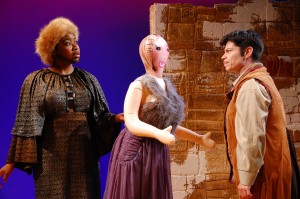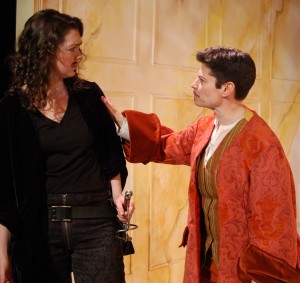New York theater is known for challenging the status quo, and that is what the Queen’s Company is all about—breaking down barriers by creating gender-blind performances of the classics and reaching out to a broader, more diverse community in its perspective on those classics, in particular Shakespeare. Artistic director Rebecca Patterson’s vision shows she understands that Shakespeare transcends time and place. His characters represent all of humanity and hit at a deeper core—the truly humane one. Because every actor was cast according to how her personality fit the role, not according to gender, the production is an organic ensemble theatrical experience.
Patterson, a Lucille Lortel Award winner, is an actor’s director. Every moment in the play was active, honest and alive with brilliance. Having the role of Bianca played by the lovely Sweetie Doll (a blow-up sex doll) was a hysterically funny touch. In that single choice, Patterson shows one of the most important themes of the play—women’s oppression by men’s control of sexuality. Choices in music that fit key moments of the performance further heighten that theme and the emotional tension of this famous love story. Particularly funny yet thought-provoking was the pantomime of a Tina Turner song performed by Petruchio’s motley servants, led by Ashley Samona Baker as Grumio. As they perform, Katharina fights her shrewish instincts to be right. The lyrics and their playful performance reveal the inner conflict of that moment when Kate breaks and realizes she is fighting a losing battle.
The cast is perfect. The entire ensemble deserves praise for playing multiple roles with ease. Elizabeth Preston as Petruchio was spot on. Catherine Dalton as Hortensio was delightful in her Brant Russell physicality. Their playful interaction was reminiscent of Orlando Bloom and Johnny Depp in Pirates of the Caribbean. But Preston was no overacting pirate; she was more like Depp in Chocolat—sexy, sensitive, cool. She captured Petruchio’s arrogance and willfulness, but also his vulnerability. Preston reveals Petruchio’s genuine respect and interest in Katharina when Petruchio reflects on how Katharina aggressively deals with Hortensio as the ill-fated music instructor: “Now, by the world, it is a lusty wench. I love her ten times more than e'er I did.” Preston’s performance breaks the gender barriers, yet nothing is overstated or falsely posed. In her direction, Patterson has shown the true meaning of Petruchio and Katharina’s relationship—they represent all the nuances of falling in love and giving oneself over completely to another.
Tiffany Abercrombie is a stoic Katharina, creating a mother of the modern woman. The chemistry between Petruchio and Katharina is crucial to this play, and these two sensual interpretations reveal perhaps a more honest point Shakespeare was making—that love is not a prideful battle but a partnership made from love and respect. Under Patterson’s thoughtful direction, Abercrombie’s heartfelt confession as Katharina, as she infamously reprimands women, becomes more a proclamation of true love. And Petruchio’s response becomes that of a repentant faithful lover.
Their final kiss truly is a declaration of respectful love. It no longer is an issue of man’s will against woman’s but more about how wonderful love can be when it is with the mate who is a perfect match. Patterson’s interpretation gives Shakespeare’s play a fairy-tale ending of renewed faith in love, not a battle of wills and submission.
The set, lighting and costuming were simple and basic, with a dance of colors rich with textured fabrics of wool, fur, and velvet fully enhancing the raw beauty of the time and place of this wonderful play. Muted blue lighting against the brown wools and furs for the servants, the burgundy velvet for Baptista, and the bold red lace for Katharina mirrored the emotions of the characters but also reflected the barriers of caste and class.
Patterson’s talented entourage of technical artists worked seamlessly within her artistic vision. Set designer Angelica Borrero, lighting designer Alberto Ruiz, costume designer Elizabeth Flores and sound designer Beth Lake created an atmosphere that set the tone and playful mood of this timeless story. Patterson and her troupe really honored Shakespeare and all he represents in theatrical history. For Shakespeare lovers, this is a must-see production.
The Queen’s Company’s The Taming of the Shrew runs through May 1 at the Wild Project (195 East 3rd St., between Avenues A and B). Performances are at 8 p.m. Tuesday through Saturday and at 3 p.m. on Sunday. Tickets are available by calling (866) 811-4111. Tickets are 2-for-1 on Tuesday nights. For information, visit http://QueensCompany.org.









